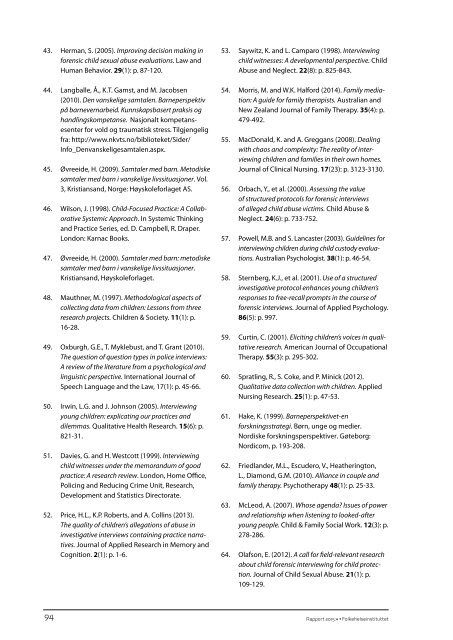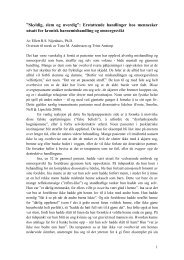rapport 2015:4
641aa6d88d
641aa6d88d
You also want an ePaper? Increase the reach of your titles
YUMPU automatically turns print PDFs into web optimized ePapers that Google loves.
43. Herman, S. (2005). Improving decision making in<br />
forensic child sexual abuse evaluations. Law and<br />
Human Behavior. 29(1): p. 87-120.<br />
44. Langballe, Å., K.T. Gamst, and M. Jacobsen<br />
(2010). Den vanskelige samtalen. Barneperspektiv<br />
på barnevernarbeid. Kunnskapsbasert praksis og<br />
handlingskompetanse. Nasjonalt kompetansesenter<br />
for vold og traumatisk stress. Tilgjengelig<br />
fra: http://www.nkvts.no/biblioteket/Sider/<br />
Info_Denvanskeligesamtalen.aspx.<br />
45. Øvreeide, H. (2009). Samtaler med barn. Metodiske<br />
samtaler med barn i vanskelige livssituasjoner. Vol.<br />
3, Kristiansand, Norge: Høyskoleforlaget AS.<br />
46. Wilson, J. (1998). Child-Focused Practice: A Collaborative<br />
Systemic Approach. In Systemic Thinking<br />
and Practice Series, ed. D. Campbell, R. Draper.<br />
London: Karnac Books.<br />
47. Øvreeide, H. (2000). Samtaler med barn: metodiske<br />
samtaler med barn i vanskelige livssituasjoner.<br />
Kristiansand, Høyskoleforlaget.<br />
48. Mauthner, M. (1997). Methodological aspects of<br />
collecting data from children: Lessons from three<br />
research projects. Children & Society. 11(1): p.<br />
16-28.<br />
49. Oxburgh, G.E., T. Myklebust, and T. Grant (2010).<br />
The question of question types in police interviews:<br />
A review of the literature from a psychological and<br />
linguistic perspective. International Journal of<br />
Speech Language and the Law, 17(1): p. 45-66.<br />
50. Irwin, L.G. and J. Johnson (2005). Interviewing<br />
young children: explicating our practices and<br />
dilemmas. Qualitative Health Research. 15(6): p.<br />
821-31.<br />
51. Davies, G. and H. Westcott (1999). Interviewing<br />
child witnesses under the memorandum of good<br />
practice: A research review. London, Home Office,<br />
Policing and Reducing Crime Unit, Research,<br />
Development and Statistics Directorate.<br />
52. Price, H.L., K.P. Roberts, and A. Collins (2013).<br />
The quality of children’s allegations of abuse in<br />
investigative interviews containing practice narratives.<br />
Journal of Applied Research in Memory and<br />
Cognition. 2(1): p. 1-6.<br />
53. Saywitz, K. and L. Camparo (1998). Interviewing<br />
child witnesses: A developmental perspective. Child<br />
Abuse and Neglect. 22(8): p. 825-843.<br />
54. Morris, M. and W.K. Halford (2014). Family mediation:<br />
A guide for family therapists. Australian and<br />
New Zealand Journal of Family Therapy. 35(4): p.<br />
479-492.<br />
55. MacDonald, K. and A. Greggans (2008). Dealing<br />
with chaos and complexity: The reality of interviewing<br />
children and families in their own homes.<br />
Journal of Clinical Nursing. 17(23): p. 3123-3130.<br />
56. Orbach, Y., et al. (2000). Assessing the value<br />
of structured protocols for forensic interviews<br />
of alleged child abuse victims. Child Abuse &<br />
Neglect. 24(6): p. 733-752.<br />
57. Powell, M.B. and S. Lancaster (2003). Guidelines for<br />
interviewing children during child custody evaluations.<br />
Australian Psychologist. 38(1): p. 46-54.<br />
58. Sternberg, K.J., et al. (2001). Use of a structured<br />
investigative protocol enhances young children’s<br />
responses to free-recall prompts in the course of<br />
forensic interviews. Journal of Applied Psychology.<br />
86(5): p. 997.<br />
59. Curtin, C. (2001). Eliciting children’s voices in qualitative<br />
research. American Journal of Occupational<br />
Therapy. 55(3): p. 295-302.<br />
60. Spratling, R., S. Coke, and P. Minick (2012).<br />
Qualitative data collection with children. Applied<br />
Nursing Research. 25(1): p. 47-53.<br />
61. Hake, K. (1999). Barneperspektivet-en<br />
forskningsstrategi. Børn, unge og medier.<br />
Nordiske forskningsperspektiver. Gøteborg:<br />
Nordicom, p. 193-208.<br />
62. Friedlander, M.L., Escudero, V., Heatherington,<br />
L., Diamond, G.M. (2010). Alliance in couple and<br />
family therapy. Psychotherapy 48(1): p. 25-33.<br />
63. McLeod, A. (2007). Whose agenda? Issues of power<br />
and relationship when listening to looked-after<br />
young people. Child & Family Social Work. 12(3): p.<br />
278-286.<br />
64. Olafson, E. (2012). A call for field-relevant research<br />
about child forensic interviewing for child protection.<br />
Journal of Child Sexual Abuse. 21(1): p.<br />
109-129.<br />
94<br />
Rapport <strong>2015</strong>:4 • Folkehelseinstituttet



